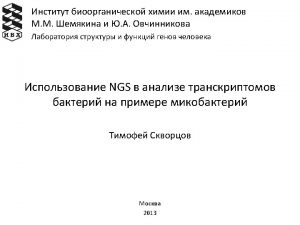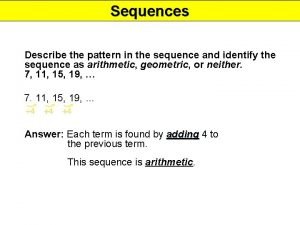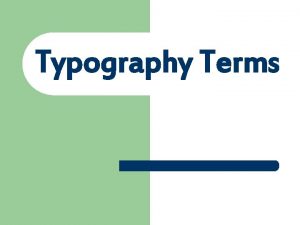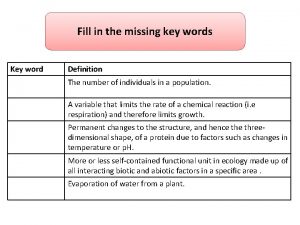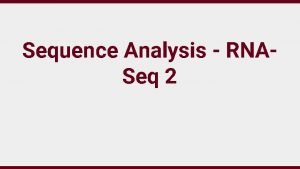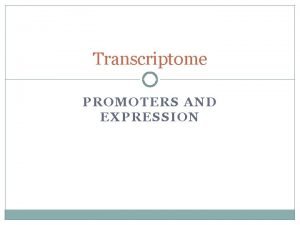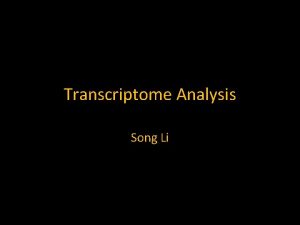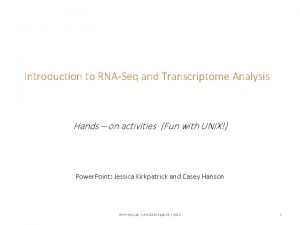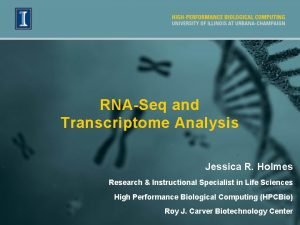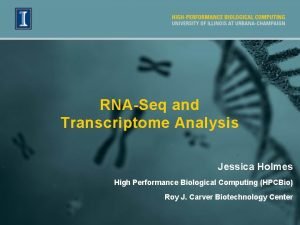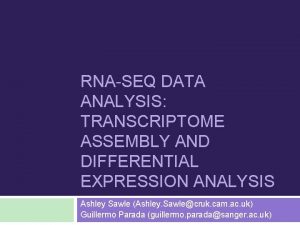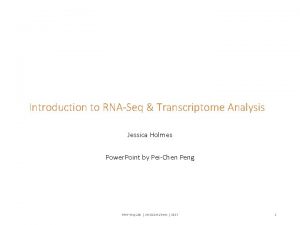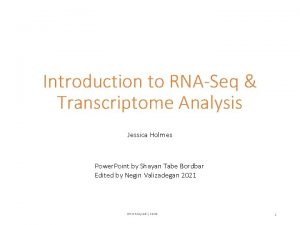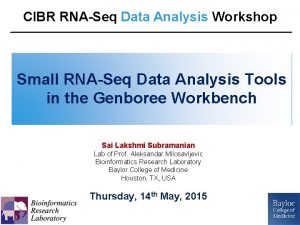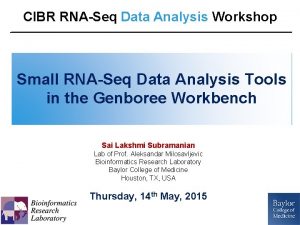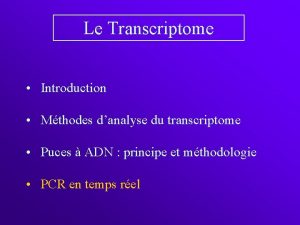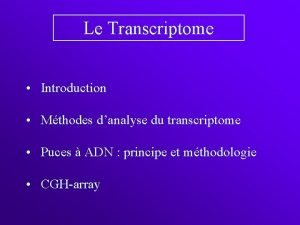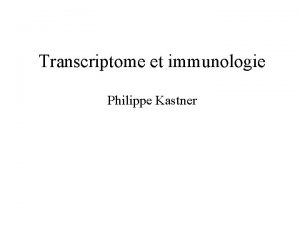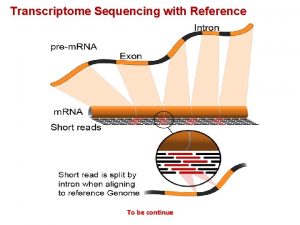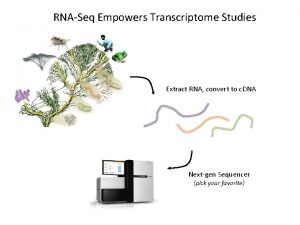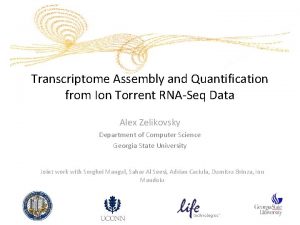Sequence Analysis RNASeq 1 The Transcriptome Complete set



















- Slides: 19

Sequence Analysis - RNASeq 1

The Transcriptome ● Complete set of RNA transcripts in the cell ● Many types of RNA, e. g. : ○ m. RNA ○ linc. RNA ○ Anti-sense ○ r. RNA ○ Small molecules: ■ t. RNA, sno. RNA, mi. RNA, pi. RNA, etc

Transcriptome Studies From abundance ● Gene expression ● Transcriptional regulatory networks ● Biological pathway discovery From sequence ● ● ● Alternative splicing Amino acid sequence Fusion transcripts RNA editing Gene discovery Coding variants

RNA-Seq ● Identify sequence of RNA molecules ● “Unbiased” - possible to sequence any molecule in sample ● Molecules sequenced in proportion to relative abundance in sample ● Most often used for gene abundance estimation

RNA-Seq Library Construction

Design Choices & Considerations ● ● ● ● Single vs paired end Read length Ribosomal Depletion Strategy Fragment length RNA Integrity Stranded vs Unstranded Library size Multiplexing

Design Choice: Single vs Paired End ● Single end vs paired end ○ 2 x more distinct molecules sequenced ○ Harder to find reads spanning splice junctions ● For RNA-Seq, use paired end

Design Choice: Read Length ● Read length determines mappability ● Longer reads: ○ more unique sequence → more uniquely mappable ○ more likely to span splice junction ● Shorter paired reads better than longer single end (why? ) ● 2 x 75 bp enough for hg, 2 x 150 bp overkill

Design Choice: poly-A or Ribo-depletion ● ~95% of RNA in cell is ribosomal RNA ● 5 S, 5. 8 S, 18 S, 28 S in humans ● Two removal strategies: ○ poly-A selection (positive) ■ poly-A capture ■ Only poly-A transcripts (m. RNA) ○ Ribo-depletion (negative) ■ Probe-based r. RNA capture ■ Leaves all other RNA sequence

Removing r. RNA: poly-A (m. RNA-Seq) ● Enriched for m. RNA (protein coding) ● Little pre-m. RNA/ linc. RNA/etc ● �� Splicing analysis ● �� Sensitive to low RIN ● �� 3’ degradation bias https: //bmcgenomics. biomedcentral. com/articles/10. 1186/1471 -2164 -15 -284

Removing r. RNA: Ribo-depletion (RNA-Seq) ● ● ● ● Removes r. RNA with probes �� Diverse RNA sequences Relatively less protein coding Little to no 3’ bias Fewer spliced/exonic reads �� Effective for degraded RNA �� Harder to interpret protein effects https: //www. neb. com/-/media/catalog/application-notes/selective-depletion-of-abundant-rnas-to-enable-transcriptome-e 6310. pdf? rev=214 e 1 d 46 d 2834 c 12876 fa 0867 ea 5197 d

Large RNA Size Selection ● Gel cut (old method): ○ Size select with gel electrophoresis ○ Fragment size distribution may indicate RNA quality ○ Select ~300 nt fragments by gel cut ● SPRI Beads (current method) https: //www. researchgate. net/publication/280870031_Informatics_for_RNA_Sequencing_A_Web_Resource_for_Analysis_on_the_Cloud/figures? lo=1

Small RNA Size Selection https: //www. researchgate. net/publication/231742684_Preparation_of_Small_RNA_Libraries_for_High-Throughput_Sequencing/figures

Batch effect: Fragment Length Distribution ● Inner mate distance: unsequenced length between read pair RNA Fragment (300 nt) Read 1 (100 nt) 100 nt Read 2 (100 nt) RNA Fragment (150 nt) Read 1 (100 nt) Read 2 (100 nt) -50 nt Inner Mate Distance

Design Consideration: RIN ● ● RNA Integrity Number Measurement of RNA quality 10 - best, 0 - worst Transcripts ○ degrade 5’ → 3’ ○ At different rates! ● Rules of thumb ○ ○ >8 �� 6 -8 is ok if necessary 3 -6 is ok only if very necessary <3 �� https: //infravec 2. eu/rna_seq/

Design Choice: Stranded vs Unstranded ● Stranded libraries maintain strand of molecule in reads ● Unstranded do not ● Important to resolve: ○ Bi-directional transcription ○ Anti-sense transcripts ○ Overlapping genes ● Modern RNA-Seq library prep kits are stranded

Design Choice: Library Size & Multiplexing ● Library size: # of reads per sample ● Depending on who you ask, a read is: ○ A RNA fragment (same for single/paired end) ○ One FASTQ record (not same for single/paired end) ● Library size is target , # reads will vary ● Rules of thumb for human transcriptome: ○ poly-A: 30 M for expression, 80 M alternative splicing ○ ribo: 50 M for expression, 100 M alternative splicing

Design Choice: Multiplexing ● Add unique barcode (index) to each sample library ● Multiplexed samples pooled and sequenced together → avoid lane batch effects ● Data will usually be demultiplexed for you

Design Choices & Recommendations ● ● ● ● Fragment length: ~300 nt (large RNA) RNA Integrity: >8�� , >6 ok, >3 if need be Ribosomal Depletion Strategy: depends Single vs paired end: paired Read length: 2 x 75 bp Stranded vs Unstranded: stranded Library size: poly-A 30 -80 M, ribo 50 -100 M Multiplexing
 Rnaseq illumina
Rnaseq illumina Total set awareness set consideration set
Total set awareness set consideration set Training set validation set test set
Training set validation set test set Nucleotides of rna
Nucleotides of rna Selection in pseudocode
Selection in pseudocode Difference between finite and infinite series
Difference between finite and infinite series Convolutional sequence to sequence learning
Convolutional sequence to sequence learning Complete the sequence below and explain the pattern
Complete the sequence below and explain the pattern Bounded set vs centered set
Bounded set vs centered set Fuzzy logic
Fuzzy logic Crisp set vs fuzzy set
Crisp set vs fuzzy set Crisp set vs fuzzy set
Crisp set vs fuzzy set What is the overlap of data set 1 and data set 2?
What is the overlap of data set 1 and data set 2? Correspondence function examples
Correspondence function examples Swensons technique of occlusal modification
Swensons technique of occlusal modification Typography terms
Typography terms Bacterial growth
Bacterial growth Subject and simple subject
Subject and simple subject Hình ảnh bộ gõ cơ thể búng tay
Hình ảnh bộ gõ cơ thể búng tay Slidetodoc
Slidetodoc
